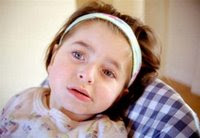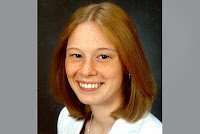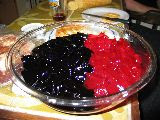
August 7, 2006
Saint You Know Who Hospital Emergency Room
Ashley knew where she was the minute we tried to push her wheelchair through the emergency room doors. She was probably alerted by the hospital smells and the sense of many anxious people around her. Already in intense pain, she pushed herself back in her wheelchair as hard as she could, tensed her body and uttered “eye-ya-uh”, her deaf-speak for “What the hell?”Ashley is 11 years old and deafblind. Born 14 weeks prematurely, she has had two brain tumors removed, many ear and eye surgeries, her gallbladder removed, and a g-tube inserted into her stomach for feeding. She has been in hospitals literally hundreds of times since she was born – and at Saint You Know Who Hospital enough times to have a wing, or at least a meeting room, named in her honor. Throughout the years, she has become accustomed to hospitals and usually tolerates them well. Today, with the intense pain she was feeling, was an exception. Two months ago, a nurse practitioner associated with the hospital and with Ashley’s gastroenterologist wanted to experiment with a differently designed G-tube for Ashley. The experiment went horribly wrong and resulted in lacerations, bruising and swelling to Ashley’s G-tube stoma (the hole into her stomach). Since that day two months ago, Ashley had many problems with the g-tube stoma including infections and continued pain. She had already been at the emergency room once before with the problems, and had also had several visits to the pediatrician’s office. But again today the pain and swelling took a turn for the worse, and another visit to the emergency room was needed.
Ashley’s anxiety level began to rise significantly and her desire and ability to communicate via sign language diminished. Her communication was now visible primarily in her behavior. As we moved to the registration desk, Ashley began fighting me and her aide, hitting us, trying to bite us, and kicking us. She threw her comfort object (a ball of her favorite pipe cleaners and beads) hard against the glass window of the registration booth. A hospital volunteer leaned in and whispered “Maybe you should take it away from HIM.” I stared in amazement at this person who had no knowledge whatsoever of my daughter with exceptional special needs trying to tell me how to handle her anxiety. Ashley’s aide looked at the volunteer with suppressed anger in her eyes and said “I think we can handle it.”The woman at the registration desk was sympathetic to Ashley and our problems in trying to contain her aggressiveness. She moved as quickly as she could to get us registered, and then moved us just as quickly to triage, the place where a nurse evaluates the patient before moving back to the actual emergency room and treatment. Unfortunately, there was no nurse in triage, and again Ashley panicked, began flailing her arms, hitting me and her aide, biting herself, trying to bite us, hitting her head over and over again, and trying desperately not to allow her chair into the very, very small triage area. Another parent holding a toddler and waiting for admission to the emergency room was sitting behind Ashley’s wheelchair. When Ashley threw herself back in the chair yet again, she was inches away from hurting the mother and her child. Still, the triage nurse had not arrived. When she finally did arrive, Amy, Ashley’s aide, and I were doing our best to physically hold Ashley in her chair, all the while trying to avoid being bitten and kicked. Amy has a broken wrist and I have rheumatoid arthritis which means my joints are painful and swollen most of the time. I believe it should have been obvious, especially to medically trained people, that we were having an extremely difficult time.
When the triage nurse finally arrived back at her station, I immediately asked for assistance with Ashley’s aggressive behavior. She told me she would get to that but had to get some information first. So, while Amy and I physically immobilized Ashley as best we could, sustaining injuries during the process, I went over yet again the extent of Ashley’s disabilities. I also again asked for assistance and the triage nurse told me she was working on that. Ashley was working on hurting herself and biting me.Finally, the triage nurse had called enough people, three I believe, to get someone to meet us at the main emergency room door and escort us back to a room. Still, Amy and I were physically trying to restrain Ashley and keep her from hurting herself even more. As we walked past the nurse and doctor station in the pediatric emergency room, three people behind the station (all nurses, I assumed) stared without stopping. Had any of my three children stared like that, I would have disciplined them. No one smiled. No one greeted us. No one said anything – but the staring continued. We were ushered into a room, the same room where several years ago Ashley had almost died. She remembered the room.
At the door to the room that Ashley remembered from the time when she had been intubated and finally medically paralyzed to stop a seizure, she again threw herself back in her wheelchair, again injuring me. When she realized that she would be able to lie down, she did settle down. Her pain subsided somewhat when she was lying down. So, she was agreeable when it came time to transfer her to the hospital bed. The nurse that had escorted us to the room said nothing. She left the room, but returned a few minutes later with a much older nurse, and said she needed to get vital signs on Ashley. I was worried that if Ashley became aggressive again, the older nurse would be injured. It was obvious that she would not be a physical match for Ashley. Amy and I were communicating with Ashley via sign language, which was a good thing because the two nurses made no attempt to communicate with her at all. Ashley cooperated through the blood pressure and temperature check because her pain had subsided somewhat since she was lying down. She was however very cold. As the nurse left the room, I asked if we could get Ashley a blanket.
Ashley was shivering and her teeth were chattering because she was so cold. I could see the goose bumps on her arms. Since we had no blanket, and couldn’t see if anyone was bringing one, Amy started looking through the cabinets in the room. She found a thin sheet, and we wrapped Ashley in that.A nurse-practitioner came into the room. She did not introduce herself but she did have a badge on. She looked at Ashley, made no attempt to touch or communicate with her, but asked me what the problem was. I explained the whole story about the g-tube problems, and told her that the problems had surfaced again today, resulting in extreme pain for Ashley. The nurse-practitioner asked me what I thought the problem was with the G-tube. Sarcastically, I admit, I said that if I knew what the problem was, we probably wouldn’t have come to the emergency room. The nurse-practitioner asked me what I thought needed to be done. I’m sure the sarcasm was apparent in my eyes when I said “Perhaps we need to call Dr. W., Ashley’s gastroenterologist, and see what he recommends.” She said “Okay”, but said first we would get an X-ray to see if the tube was placed correctly and functional. She didn’t actually say functional but used a term I had never heard before. I had to ask what the term meant. She told me and then turned and left the room.
Ashley was still shivering. She signed “cold” and “hurt” and then started hitting her head. I walked out to the nurse’s station, waited approximately 3 minutes for anyone to look up from what they were doing, and even though no one asked what I needed, I said again that a blanket was needed for Ashley. The nurse that had escorted us to our room turned and went to get a blanket. She then brought it into the room, handed it to me and left without saying anything. Soon after that, a person I had not previously seen, walked in and said she was taking Ashley to X-ray. As with every other person we had seen or interacted with that day, she did not smile; she did not greet Ashley; she said nothing.
Ashley was cooperative as she was being wheeled on her bed to X-ray. She had Amy and me beside her and she had her battery toothbrush, an object that she often uses to comfort and calm herself. She was even cooperative as two people in X-ray slid her from her bed to the X-ray table.The X-ray technician was preparing the dye to be inserted into Ashley’s G-tube to get a picture of what was happening internally with the tube. The technician approached Ashley with a 60 ml syringe but then looked puzzled trying to figure out how she was going to get it into the tube. I asked if she had one of the required G-tube connectors, and she said she did not. I told her that was the only way to get the dye into the tube. I then offered that I had a connector back in Ashley’s ER room which I had brought just for a situation like this. The technician said nothing, but I opened the door and asked Amy to get the connector for me.
Once I had the connector, I accepted the syringe of dye from the technician and inserted the dye into Ashley’s tube. As the technician was preparing the slide for the X-ray, I asked if I needed to put on one of the protective aprons. She said “Oh yea, you do.” I’m glad I asked. The X-ray was taken, and Ashley was returned to her ER room.
A long time went by before anyone came back into Ashley’s room. Fortunately, Ashley’s battery toothbrush was doing the trick for keeping her calm, but it was obvious that she was getting tired of being in the bed and in the room. Finally, the nurse-practitioner returned to the room and said everything looked fine on the X-ray. When she said nothing else, I asked why Ashley was in pain and what was going to be done for her. The nurse-practitioner said that we were to go and see Dr. W. in his hospital office.
As Amy and I were attempting to get Ashley to move from the bed back into her wheelchair, the nurse who had shown us to our room arrived with discharge papers for me. She stood by, not saying a word, as Amy and I continued to struggle with Ashley. When I saw that Ashley was again becoming agitated and aggressive, and I was worried that she might be about to hurt Amy, I lunged forward to restrain her. I caught my foot on Ashley’s wheelchair and fell, bruising and cutting my left shin. I pulled my pants leg up and saw blood dripping and the bruise already starting to form. The nurse turned and left the room, never asking if I was ok, if I needed anything. Amy and I got Ashley into her wheelchair and started out of the room. With blood dripping from my shin, the nurse handed me the discharge papers to sign.Since Ashley was once again in her wheelchair in the position that caused her the most pain, her aggressive behaviors again increased. She struck herself in the head more times than we could count, and both Amy and I were doing our best to restrain her and push her wheelchair at the same time. We had about a 25 minute wait in the doctor’s waiting room, enough time for Ashley to throw almost every toy in the room and totally tear apart a silk flower arrangement. When the nurse finally called us back, she took us first into a room where Ashley would be weighed and have her height checked. Since Ashley’s behavior was increasing and because I could share with the nurse the height and weight taken at the pediatrician’s office less than a week prior, I didn’t understand why this step couldn’t have been skipped. But, it could not according to the nurse.
After the height and weight struggle, we were ushered into an examination room, where we spent the next 45 minutes trying to keep Ashley from hurting herself or us anymore than she already had. During that 45 minutes, Amy walked to the nurse’s desk and tried to explain the seriousness of the aggression and why waiting was not working. But still we waited. I then walked to the nurse’s desk and was told the doctor would be in very soon. Very soon meant another 15 minutes.
Dr. W. walked into the room, donned gloves, and while Amy and I were lying across Ashley to try to keep her still and not hurting anyone, Dr. W. examined her G-tube area. He said there was scar tissue that had grown and that it needed to be chemically treated with silver nitrate. The only time anyone had to use silver nitrate on Ashley before was right after the tube was inserted when she was two years old. This fact only served to confirm my thoughts that the brutal attempt at a different model of G-tube was the original cause of all Ashley’s current problems.
In less than 5 minutes, Dr. W. was in the office, used the silver nitrate, and exited the office. Finally, it was time for Amy, Ashley and me to go home. It was impossible to tell which of us was the happiest at that point.
The day all this transpired, Monday, August 7th, began as a pretty normal day. But, by the time Ashley arrived at school, she was bleeding from her G-tube and complaining of intense pain. Little did Amy and I know at that time that a 5 minute procedure would address the problem Ashley was having. Little did we know that we would spend four and a half hours getting to those 5 minutes.
Ashley was so happy to be home. Even though the silver nitrate was stinging a little, the comfort of her home, surrounded by people who love her, respect her, and treat her with dignity was enough to help her settle down and return to the loving, happy child she normally is. After dinner, she fell easily asleep, but I worried if she would dream of the trauma, the disrespect, and the inhumanity she had endured during the day.









